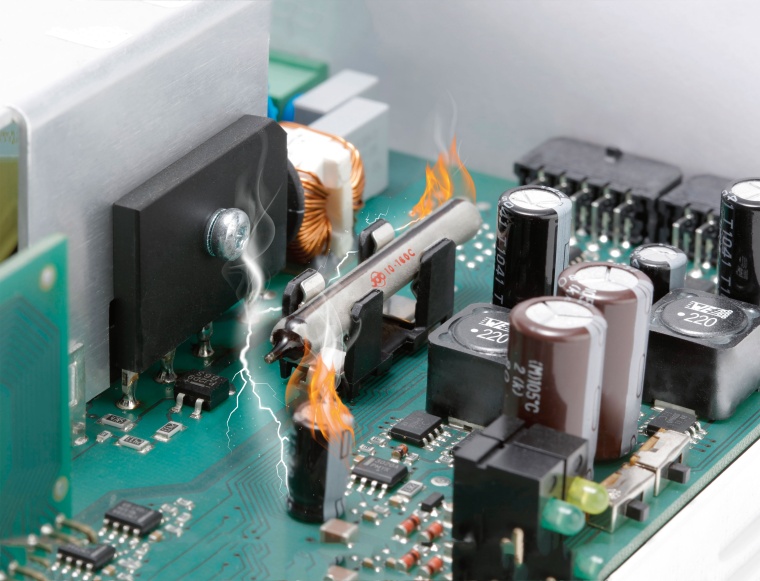Small Fire Extinguisher Helps to Mitigate Fire Risks
A robust glass bulb is triggered when a certain temperature is exceeded, it bursts and releases the extinguishing agent




An innovative and device-integrated fire protection concept can reduce the inherent fire risk that comes with any electrical cabinet, device and appliance; components so small that they fit inside electrical products, detect and suppress emerging fires directly at the point of origin and at the earliest possible point in time. This approach minimizes the fire risks for people and helps to prevent fire-related service interruptions and economic damage for operators and insurers.
Electricity is dangerous. Statistically, the fire services are called to a fire scene in Europe and North America every two minutes. Electricity, electrical systems and electronic devices cause one in three of these fires (Source: Institut für Schadenverhütung und Schadenforschung, Kiel 2020). In practice, there might even be more fires that are often not reported for fear of possible consequences such as investigations, raised insurance premiums or simply because prompt and competent intervention by the people who were there avoided more serious damage, particularly in industrial environments.
Reports of fires make it into the news regularly. Some recent examples include the tragic hospital fire in Western India in which 18 COVID patients were killed (April 2021), the severe fire at a subway station in Berlin (January 2021) or the devastating fire at the Timmelsjoch Historic Bike Museum in Austria in January 2021. Luckily, no one was injured in this fire.
Most often, only minor causes lead to all these fires, but they cause significant damage and operational downtimes, the evacuation of stations and costly business interruptions.
Devastating Impact
The impact of fires is frequently devastating – not only for the people affected but also for the companies that are economically linked to such an incident. Costs for repairs and replacement of damaged equipment, vehicles or devices often represent the lesser evil – the largest damage is caused by the concomitant service interruptions. In 2022, the well-known Allianz risk barometer listed these ‘service interruptions’ as the second largest risk for companies world-wide. In the last years only cyber security threads rank higher.
According to the German VdS (100% subsidiary of the German Insurance Association, GDV), a renowned institute for corporate security and safety specializing in fire protection, security and natural disaster prevention) , every third fire causes material damage of more than EUR 500,000, with the result that the affected companies often do not recover from the incident. Only 23 percent of the companies that were affected by fire can resume their business operations fully. More than 40 percent of the companies, however, have to discontinue their business after a fire (cf. ‘Logistik Heute’). For owners, operators, transport carriers and insurers this means standstills, unhappy customers, cancellations and delays, long discussions, investigations and bureaucratic efforts.
Current fire prevention and protection standards are often cited as being sufficient to prevent fire-related accidents. Manufacturers of all kinds of technology (like power supplies, digital signage equipment, household appliances, production machines and infrastructure equipment) routinely look at fire protection just as the ‘necessary evil’. Driven only by economic considerations, such companies just implement the minimum that is legally required without being aware of the potential economic impact on their own business, and the potential harm for their customers, as well as all the other stakeholders involved. If implementing current fire protection requirements were sufficient, one can ask why do fires still happen so frequently?
Insufficient Thought about Fire Protection
Behavioral studies suggest that one of the reasons why humans tend to repress thoughts about the risks of fires can be found in the typical pattern of thinking. The brain is ‘wired’ to use heuristic thinking in complex and unknown situations (cf. Mintzberg, “The Structure of ‘Unstructured’ Decision Processes”, 1976). People are using their ‘gut feeling’ and trust their perception and senses rather than what knowledge and education would suggest. A typical example from the fire prevention industry is what people do when a fire alarm is set off. As long as there is no smoke or other obvious signs of fire (such as the fire brigade’s emergency forces or first aiders showing up), people tend to assume that this MUST be a false alarm because there is no fire to be seen or felt. Tragically, this often continues to happen until it is too late for evacuation or escape (cf. Kemerovo Shopping Center Fire, 2018).
Every Third Fire Caused by Electrical Devices and Systems
There is a wide variety of causes for electrical fires: faulty components, poor soldered joints, manufacturing faults, intermittent plug connections, impermissible operating conditions or sudden component failures. Users and consumers are then threatened by fire, resulting in product failures and even product recalls. Common protective measures like fault current switches, contactors or fuses often recognize a fault condition very late or not at all. Many of the fault sources cannot be directly influenced by the manufacturer or operator, which is the reason why such risks can often not be recognized or considered.
The existing fire protection concepts are of course very extensive already and their application saves lives and property in many places. The currently adopted fire protection model used in most industries relies on organizational fire protection (e.g. escape routes and fire protection assistants), technical fire protection (e.g. fire alarm systems or smoke detectors), structural fire protection (e.g. fire doors and walls) as well as defensive firefighting by fire brigades and first aiders. The existing standards, concepts and technical solutions are undoubtedly good – they work and save people. With the statistics mentioned above as a basis however, it may prove beneficial to consider further options to increase fire protection beyond the legally required minimum.
Device-integrated Fire Protection
Almost all fires start small. Many large fires could be prevented if an emerging fire was detected and extinguished early and directly at its point of origin. This is the approach taken by an innovative ‘device-integrated fire protection’ concept. Modern fire extinguishing components are so small that they can be installed directly onto printed circuit boards, inside power supplies and any other powered device.
One related innovation is the E-Bulb, a robust glass bulb similar to the ones used in fire sprinklers. These bulbs, the size of commercial micro fuses (5x20mm, 5x40mm, 7x40mm), are filled with a non-conductive, non-toxic, NOVEC engineered fluid made by 3M. The glass surface is coated and electrically conductive, which means it can be integrated into the power supply circuit. The glass bulb is calibrated in such a way that if a defined trigger temperature is exceeded, it bursts and releases the extinguishing agent directly inside the device where the fire was detected. This extinguishes an emerging fire immediately. The selection of the suitable E-Bulb for a given application can be made, for example, according to EN15004-2. NOVEC has a very low evaporation point and becomes a gas at the moment of its release. This endothermic process effectively extinguishes even a high-energy fire through cooling, without leaving any residue of the extinguishing agent or causing collateral damage of the device. The temperature-induced activation also destroys the conductive surface of the glass bulb, interrupting the electric current flow over the glass bulb reliably and permanently. As a result, the electric fire cannot re-ignite from the power supplied.
The effectiveness and reliability of the patented E-Bulb has been tested and confirmed by UL, but also by accredited organizations like VDE and MPA, as well as by the German VdS (VDS 2344 and VDS 2562). Since the protected volume is limited by its compactness, typical applications for the E-Bulb are small, clearly defined enclosures and housings, such as power supplies, monitors and and display or control units of household appliances. By incorporating a small fire detection and suppression device like the E-Bulb, an electrical device like the presentation monitor mentioned earlier can be installed and operated safely in public and semi-public areas (e.g. hospitals, train stations, shopping centers and airports). Digital signage applications with integrated extinguishing protection are being operated at Frankfurt International Airport (and others) where they are also approved for operation along the critical escape and traffic routes.
Existing solutions such as display systems at airports and trade fairs, media pillars at stations, media cabinets in railway vehicles, even in on-board toilets and restaurants, as well as in simple fuse boxes in hotels all demonstrate the efficiency and simplicity of the implementation, even in non-industrial environments.
By supplementing existing fire protection measures with the innovative device-integrated approach to detect and extinguish a fire, and to interrupt the electrical circuit to prevent re-ignition, operators, manufacturers and suppliers in the electrical and electronics industries can develop and implement their creative ideas using new, smart technologies while meeting the highest possible fire protection requirements. With the need for ever more competitive products, manufacturers of electronic devices are faced with the challenge of ensuring operational safety, being economically and visually attractive as well as being able to integrate new technology easily and safely. In today’s world, electrification can be expected to continue to rise and electronics are kept more often in ‘standby’ for remote control. Advanced and innovative fire protection is therefore of increased importance.
Early Detection and Extinguishing
The use of electrically-powered modern technology provides a great opportunity for succeeding in the market because customers demand more and more ‘smart’ features, convenience and digital user experiences. Manufacturers and operators of equipment have to integrate the latest technology to survive in the market. The risk of fire arising from all these electrical and electronic systems and devices is huge and can only be addressed effectively by innovative solutions that go beyond the requirements of existing standards and traditional fire protection concepts.
Reducing the risk of fire to zero is not possible. However, the adaptation of device-integrated fire protection with the smallest fire extinguisher in the world, the E-Bulb, offers an opportunity to extend existing fire protection concepts economically and to make safe products safer. For high-risk areas, the earliest possible fire detection and extinguishing directly at the fire’s point of origin not only allow for the reduction of approval times and the cost of alternative solutions, but in some cases even enable the use of such technology as digital media technology in the first place. Risk mitigation through device-integrated fire protection: the state-of-the-art way to protect people and assets, avoiding environmental pollution from fires and protecting stakeholders from the economic impact of electrical fires – a concept that is of benefit to everyone.
Business Partner
Job GmbHKurt-Fischer-Str. 30
22926 Ahrensburg
Germany
most read

When the Internet stumbles: Why DNS is important
When DNS fails, the internet stumbles-AWS outage proves resilience and redundancy are vital for digital trust

VIP-Lounge Interview: Marco Mille, Global Head of Security, Siemens AG
VIP in the World of Security: Marco Mille, Global Head of Security at Siemens AG

GIT SECURITY AWARD 2026 - The winners have been announced!
GIT SECURITY AWARD 2026: The best safety and security solutions of the year - now an overview of all winners

Assa Abloy's battery-powered Aperio KL100 secures lockers
Boost workplace security and operational flexibility by securing more than just doors.








